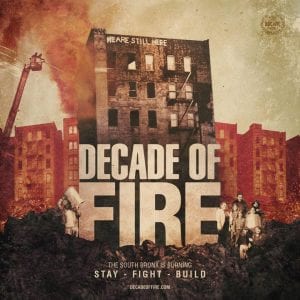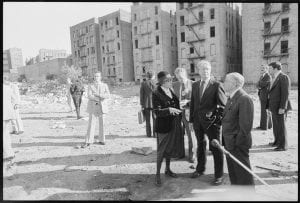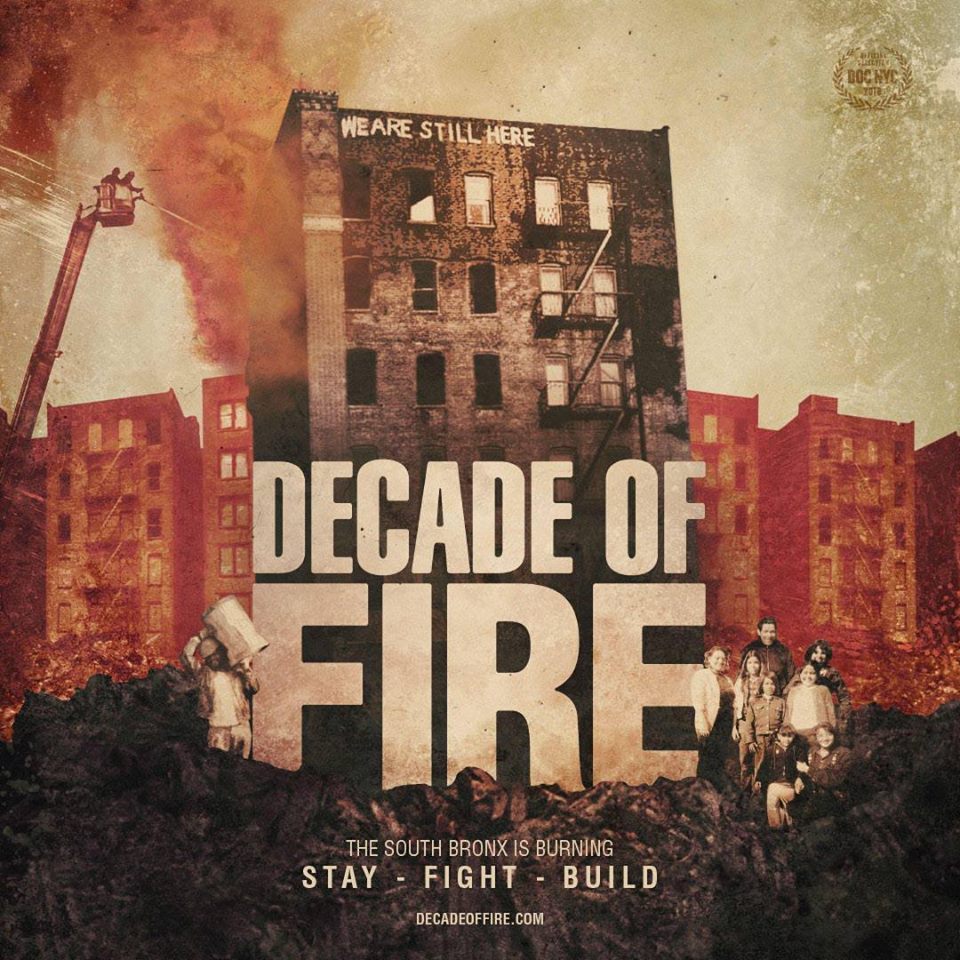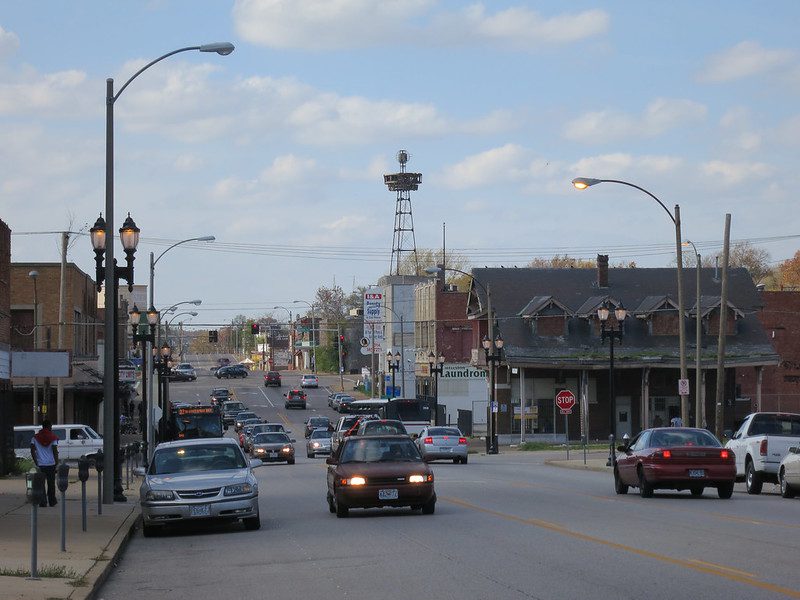
DecadeOfFire.com
Narrated and co-directed by Vivian Vázquez Irizarry, Decade of Fire tells the story of a 10-year period in the history of the South Bronx when 80 percent of the community’s housing, home to around quarter of a million people, was lost to fire. The documentary’s power comes from Vázquez Irizarry’s personal narrative of her family’s life there, the stories of community survival and resistance, coupled with a rigorously researched history of racist government policies and market practices that allowed the South Bronx to burn.
At its start, the film takes us through the history of redlining, a set of federal policies and real estate practices that systematically denied investment in and wealth building by residents of urban neighborhoods of color. Through the 1960s, the South Bronx’s Black and Puerto Rican residents were unable to access traditional credit to buy or maintain the deteriorating housing in their neighborhoods, nor were they able to get mortgages to move out to the suburbs. At the same time, their Italian and Jewish neighbors, a generation removed from being redlined themselves but now incorporated into American whiteness, had the opportunity, through the GI bill and other federal programs, to leave the city behind. In All That is Solid Melts into Air, philosopher Marshall Berman eulogizes the Bronx, while accepting culpability for what’s to come: “For children of the Bronx like myself, the road [Cross Bronx Expressway] bears a load of special irony: as we race through our childhood world, rushing to get out, relieved to see the end in sight, we are not merely spectators but active participants in the process of destruction that tears our hearts. We fight back the tears, and step on the gas.”
As whole blocks of buildings were decimated by arson—largely orchestrated by insurance payout-seeking building owners who would pay vulnerable residents to set the fires—the devastation in the borough came to a head in the late 1960s, and the city and the media looked for someone to blame. The film includes archival footage of New York City fire commissioner John T. O’Hagan attributing the spike in fires on “families from the deep South” being unable to adapt to the urban environment. Dispelling racist and classist canards such as this, and its internalization by South Bronx residents, is one of the principal goals of the film.
Blaming the deterioration of American cities on Black and Latinx residents was central to post-1960s federal and local policy making. It served as a justification for the retrenchment on social spending on housing and social services and increased spending on policing and incarceration. In Race for Profit, published in 2019, scholar and activist Keeanga-Yamahtta Taylor describes how the deterioration of living conditions in underfunded Pruitt-Igoe, a public housing development in St. Louis, was first blamed on low-income Black tenants, then used to justify further cuts across all federal housing programs: “The crisis in Pruitt-Igoe and public housing more generally was interpreted not only as the result of tenant misbehavior but also as evidence that government social welfare promoted dependency and disregard for private property.”
One of the more powerful scenes in the film is when Vázquez Irizarry follows the record trail of the South Bronx fires in the FDNY archives. Looking through the files she asks, “At the time when there were so many fires in the South Bronx, firehouses closed … makes me wonder why?”
The film tells us about the Rand Corporation, a policy think tank contracted by the city to develop “long-range planning and policy development systems.” In an early example of officials dazzled by technological solutionism and blind to algorithmic bias, the city adopted a Rand recommendation to close fire companies in poor neighborhoods to increase FDNY efficiency [for more on this history see The Fires This Time: Joe Flood on Managing New York City, a 2010 article in The Atlantic by Marc Arbinder, and the book, A Plague on Your Houses by Deborah Wallace and Rodrick Wallace]. As the number of fires in the Bronx spiked after the removal of fire services, Rand went on to make additional recommendations in other policy areas that had an impact on the Bronx, including a recommendation to end rent control.

Secretary of H.U.D. Patricia Harris, President Jimmy Carter, and New York Mayor Abraham Beame tour the South Bronx, October 1977. Photo in public domain; National Archives and Records Administration
The firehouse closures were part of a broader austerity push that defined post-fiscal crisis New York. The film highlights the Bronx’s grassroots organizing and community development movement as forces that ultimately brought the devastating era to its conclusion. The film charts efforts by residents to take over and rebuild abandoned properties, efforts that happened alongside other anti-austerity fights, like the struggle to save Hostos, New York City’s first bilingual college. Through archival footage and first-person interviews, we get to meet long time neighborhood activists like Hetty Fox who took it upon herself to renovate single-family homes on her street, as well as Leon Potts and Harry De Rienzo, founders of the Banana Kelly community development corporation that is still active in the South Bronx today.
In Race for Profit, Taylor writes, “The regressive politics of conservatism and the project of neoliberal restructuring were not the same, but in the United States each was able to influence the development of the other.” In the Bronx, austerity measures utilized during the decade of fire set the groundwork for the gentrification to come.
The film brings us into the present, when “developers want to carve up the Bronx all over again,” ending with resident resistance to the Jerome Avenue rezoning. Continuing this thread, Vázquez Irizarry and her co-directors recently released Defending Your Block: How to Stay, Fight and Build, a short film highlighting anti-displacement stories from the Bronx, Pittsburgh, and Los Angeles. Defending Your Block distills five elements of block defense: be vigilant, engage neighbors, learn the system, lead with a shared vision, and occupy space.
It ends on a hopeful note from Fanny Ortiz, an organizer from the Boyle Heights neighborhood in Los Angeles: “We are going to stay here and fight for our community.”






Comments